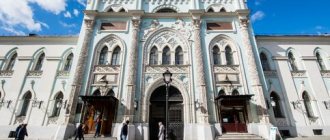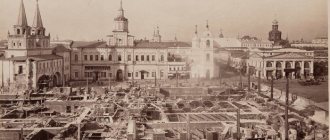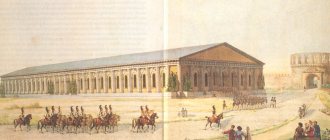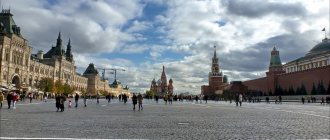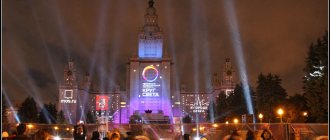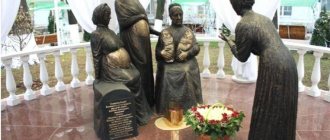18th-century classicism, also called neoclassicism, in reference to the classical tendencies of the 16th and 17th centuries, was an artistic movement that developed in Europe in the second half of the 18th century and the first decades of the 19th century, more specifically within the framework marked by the beginning of the French Revolution (1789). and the fall of Napoleon (1815). The greatest spread of this style is associated precisely with Napoleonic fortune.
Features of the development of classicism in St. Petersburg
The change from the Baroque style, which dominated Russia for a long time, to classicism occurred after Empress Catherine II came to power. Of course, this style began to develop in two key cities of the country - Moscow and St. Petersburg.
The Baroque style was distinguished by its pomp and splendor, but it was difficult to transfer it to “state buildings” such as shopping arcades, schools, hospitals, prisons, etc. This was both inappropriate and very difficult from a technical point of view, since Baroque involves a long and thoughtful design and construction of buildings. However, the needs of the young city required rapid construction.
The new direction has become ubiquitous thanks to its list of requirements for forms and decoration. Classicism significantly expanded the possibilities of urban planning.
Canons of classicism
Palladio and Scamozzi, who worked at the end of the 16th and beginning of the 17th centuries, anticipated the emergence of a new style.
Classicism in architecture finally took shape in France. Its characteristic features are easier to understand by comparing them with the features of the Baroque style. Comparison table of architectural styles
| Comparative feature | Classicism | Baroque |
| Building shape | Simplicity and symmetry | Complexity of shapes, difference in volumes |
| Exterior decor | Discreet and simple | Lush, palace facades resemble cakes |
| Characteristic elements of external decor | Column, pilaster, capital, statue | Turret, cornice, stucco molding, bas-relief |
| Lines | Strict, repetitive | Fluid, whimsical |
| Window | Rectangular, no frills | Rectangular and semi-circular, with floral decoration around the perimeter |
| Doors | Rectangular with a massive portal on round columns | Arched openings with decor and columns on the sides |
| Popular techniques | Perspective effect | Spatial illusions that distort proportions |
Early classicism in the architecture of St. Petersburg
This period began around 1760 and ended approximately 20 years later. This time is often called the era of “enlightened absolutism” due to the highly controversial methods of reign of Catherine the Great. Externally, architectural classicism stood out against the general background by the use of ancient orders, and the style was also characterized by monumental designs.
Among the first buildings of this period in St. Petersburg was the palace of Count Razumovsky. It was created between 1762 and 1766. Authors – A.F. Kokorinov and Zh.B. Wallen-Delamot. The project used elements of the Ionic and Corinthian orders, arcades, and bas-reliefs. However, when looking at the facade, you can still notice the features of Baroque, which did not want to fade into history.
Palace of Count Razumovsky
Vallin-Delamot also erected the Northern Pavilion and the Hanging Garden of the Small Hermitage, from where the famous museum originated. Yuri Felten also took part in the construction of the Small Hermitage. Several man-made creations belong to the genius Antonio Rinaldi. Among them are the monumental Marble Palace and the Tuchkov Buyan warehouse complex.
The originality of Moscow classicism
St. Petersburg in the 18th century was a young, rapidly growing city. Here there was a place for the inspiration of architects to roam. General plans for its development were drawn up, with clear, level streets decorated in the same style, which later became harmonious architectural ensembles.
With Moscow the situation was different. Before the fire of 1812, she was scolded for the disorder of the streets, characteristic of medieval cities, for the multi-styled style, for the predominance of wooden buildings, for the “barbaric”, in the opinion of the enlightened public, vegetable gardens and other liberties. “It was a city not of houses, but of fences,” historians say. Residential buildings were located in the depths of households and were hidden from the eyes of people walking along the street.
Of course, neither Catherine II nor her descendants dared to demolish all this to the ground and begin to build the city according to new urban planning rules. A soft redevelopment option was chosen. Architects were tasked with constructing individual buildings that organized large urban spaces. They were to become the architectural dominants of the city.
Late classicism in St. Petersburg architecture
This period in the architectural development of St. Petersburg is also called “Alexandrovsky”. Masters from Western Europe, who were personally invited by Alexander I, had a colossal influence on the architecture of the Northern capital. Late classicism is characterized by monumentality and pathos of images, strict lines and simplicity of composition.
One of the first buildings of late classicism in St. Petersburg is the Catherine Mining Institute. However, the most famous building of late classicism was the Kazan Cathedral. Its construction was conceived by Emperor Paul, who proposed to “sculpt” the building in the image of St. Peter’s Basilica in the Vatican. However, the final result was only vaguely similar to that prototype.
We moved to Antalya. We tell you everything in detail in our group. in contact with: https://vk.com/antalya2. Also watch our videos at YouTube:
Catherine Mining Institute
During the times of late classicism, the renovated building of the Bolshoi Theater, the house of Countess A.G. Laval and the entire complex of Vasilyevsky Island were erected. The building of the Smolny Institute was also created during these years.
Founders of Russian classicism
Matvey Fedorovich Kazakov (1738–1812) made a great contribution to the architectural appearance of the city. He never studied abroad, we can say that he created the actual Russian classicism in architecture. With their buildings with colonnades, pediments, porticos, domes, and restrained decor, Kazakov and his students sought, to the best of their ability, to streamline the chaos of Moscow streets, to even them out a little. His most significant buildings include: the Senate building in the Kremlin, the house of the Assembly of the Nobility on Bolshaya Dmitrovka, the first building of Moscow University.
An equally significant contribution was made by Kazakov’s friend and like-minded person, Vasily Ivanovich Bazhenov (1735-1799). Its most famous building is the Pashkov House. The architect brilliantly played with its location (on Vagankovsky Hill) in the layout of the building, resulting in an impressive example of classicism architecture.
The classicism style maintained its leading position for more than a century, and enriched the architectural appearance of the capitals of all European states.
Buildings of the Classical era in St. Petersburg
Undoubtedly, the era of classicism left a huge imprint on the architecture of the Northern capital. To this day, the city remains home to many beautiful buildings from that period, each with an impressive history.
Kamennoostrovsky Palace
It was built between 1776 and 1781. The author of the luxurious creation is unknown, but the construction was carried out under the supervision of the architect Felten. The architectural design of the palace is a rich country estate of the second half of the 18th century. The building is one of the outstanding monuments of the legendary style.
Mansion Laval
At the beginning of the 19th century, after much turmoil, the building came into the possession of Countess A. G. Laval. On her orders, the architect Thomas de Thomon completely restored the mansion, giving it an external monumentality. The interior design of the mansion is no less successful: a harsh and laconic design of the lobby with Doric columns, a rich and elaborate design of the main staircase, a large hall decorated with columns and a mirrored vault.
The Laval mansion is also important from a historical point of view. It was here that the Decembrists gathered before the uprising in the winter of 1825.
Marble Palace
Built according to the design of the famous Italian Antonio Rinaldi. It was erected personally for Grigory Orlov, the favorite of Catherine II. The austere appearance of the building is a hallmark of early classicism. In 1937, the Lenin Museum was located in the palace. In the 90s of the last century it became a branch of the Russian Museum. The Marble Palace is the pearl of St. Petersburg architecture, one of its most valuable elements.
Tauride Palace
It was built for Grigory Potemkin, another favorite of Catherine II. It was the largest and richest estate in St. Petersburg at the end of the 18th century. The palace is simple on the outside, which corresponds to the principles of strict classicism, but the interior decoration is amazing and completely contrasts with the external appearance.
Old Hermitage building
The historical monument belongs to the hands of the architect Felten, who built the building “in line with the Hermitage.” To do this, he used the foundation and walls of old buildings that had stood here for many years. In the 19th century, this building began to be called the Old Hermitage; it became a storage place for art objects that are now kept in the State Hermitage.
The old Hermitage successfully survived the restructuring and was called the “spare half” of the Winter Palace.
English classicism
Italy was the birthplace of classicism. From there it spread to England, where Palladio's ideas found widespread support. Indigo Jones, William Kent, Christopher Wren became adherents and continuers of the new direction in art.
Christopher Wren (1632-1723) taught mathematics at Oxford, but turned to architecture quite late, at 32 years old. His first buildings were Sheldonian University in Oxford and Pembroke Chapel in Cambridge. When designing these buildings, the architect deviated from some of the canons of classicism, giving preference to Baroque freedom.
A visit to Paris and communication with French followers of the new art gave his work a new impetus. After the great fire in 1666, it was he who was tasked with rebuilding the center of London. After this, he earned fame as the founder of national English classicism.
Architectural masterpieces of St. Petersburg from the era of classicism
The most famous buildings in St. Petersburg, which were built in the classicism style.
Main Admiralty Building
Speaking of masterpieces, the building of the Main Admiralty immediately comes to mind. It is considered one of the highest creations of all Russian classicism architecture. The Admiralty is the first shipbuilding shipyard on the Baltic Sea in Russia, which was founded on November 5, 1704 according to the personal drawing of Peter I. The appearance of the building underwent noticeable changes over time and was determined only at the end of the first quarter of the 19th century.
During the Great Patriotic War, the building was significantly damaged by shelling. However, by the end of hostilities, the architecture of this masterpiece was restored.
Kazan Cathedral
It was built and consecrated in 1811 in honor of the icon of the Kazan Mother of God. Construction took 10 years; the order to begin work was given by Emperor Paul I. The building turned out to be extremely original, although it resembled St. Peter's Cathedral in Rome in some ways.
In 1813, the great commander Mikhail Kutuzov was buried there.
Alexandrinsky Theater
Included in the architectural ensemble of Ostrovsky Square. Built according to the design of K.I. Rossi in 1828-1832. The building houses the Russian State Academic Drama Theater named after. Pushkin.
You can read about other theaters in St. Petersburg in the article at the link.
Saint Isaac's Cathedral
This is the last significant building of the era of Russian classicism. Its grandeur is emphasized by its impressive size: more than 100 meters in height and more than 110 in length. St. Isaac's Cathedral - the second after Under the rubble of a house in Magnitogorsk, an important discovery was made: the authorities turned to the victims of a building from the period of Russian classicism, for the external decoration of which polished granite columns and marble were used.
In Russia, classicism in architecture began to take root in St. Petersburg under Catherine II, and then spread to Moscow and other cities. It is characterized by simplicity and austerity of features, which is why many state and public buildings were designed in this style. The magnificent buildings that appeared became symbols of Russia.
Everything that is useful for every tourist on a trip:
- You can find and book tours online at Travelata and Onlinetours.
- You can book and compare hotel prices on Hotellook. And the apartments are on Airbnb.
- You can choose the cheapest air ticket among all airlines on Aviasales, and a train ticket on Poezd.
- Find excursions around the world on Tripster.
- Buy insurance and not worry about your health at Cherehapa.
- Rent a car to see even more interesting places on Economybookings. Or a bike on BikesBooking.
- Book airport transfer Kiwitaxi.
(Visited 748 times, 22 visits today)
Andrea Palladio and Vincenzo Scamozzi
Andrea Palladio (1508-1580) was the son of a stonemason. He himself had to continue the hard work of his father. But fate turned out to be favorable to him. A meeting with the poet and humanist J. J. Trissino, who recognized great talent in young Andrea and helped him get an education, was the first step on the path to his fame.
Palladio had excellent instincts. He realized that the customers were tired of the splendor of the Baroque, they no longer wanted to add luxury to the show, and he offered them what they were striving for, but could not describe. The architect turned to the heritage of antiquity, but did not focus on physicality and sensuality, as the masters of the Renaissance did. His attention was attracted by the rationalism, symmetry and restrained elegance of the buildings of Ancient Greece and Rome. The new direction was named after its author - Palladianism; it became a transition to the classicism style in architecture.
Vicenzo Scamozzi (1552-1616) is considered Palladio's most talented student. He is called the "father of classicism." He completed many projects designed by his teacher. The most famous of them are the Teatro Olimpico, which for many years became a model for the construction of theaters around the world, and Villa Capra, the first private house in the history of architecture, created according to the rules of an ancient temple.
Peculiarities
By the end of the 18th century, several types of urban estates had developed. The building of the house was separated from the street by a front yard, and the building itself was located in a “rest area.” Or it faced the facade, and the rest of the complex (garden, courtyard buildings) were hidden behind it. Also, the building could have equivalent street and park facades. The main rectangular building was usually decorated with a portico entrance, wings-outbuildings subordinate to the central volume were directly adjacent to the center or connected to it by galleries. This three-part volume outlined an elongated rectangular or semi-oval front courtyard.
In addition, a specific scheme of a “corner” house emerged, facing two streets and forming an angle between them. The architects transferred the same image of the “estate in the city” to public buildings, although, of course, they made them more significant. They are the most striking examples of Moscow classicism.
French direction
The famous Madame Pompadour, mistress of King Louis XV, began to promote the style. And the next overlord completed it. But since he inherited a difficult economic situation, the style acquired many bourgeois features.
Free space was given first place in the interior, and decorative elements were used only according to the most necessary parameters. The same applied to furniture. There was not much of it, and its forms were made visually stable.
Furniture from the Classical era in the Castle of Versailles Source dakelin.ru
Classicism of the French castle Source admagazine.ru
By the end of the eighteenth century, objects acquired a rectangular shape, instead of the usual wavy one. Horizontal and vertical elements, as well as joints, are emphasized. The legs are straightened and antique ornaments are introduced into the decor. The parts are tied with bows, and the upholstery is secured with furniture nails with a large gilded head.
Streamlining is replaced by a right angle and a clearly defined plane. Armchairs and chairs with low-relief carvings are becoming widespread. And among the cabinets, corner structures, secretaries and chests of drawers with whatnots gained primacy.
French classicism in the interior Source Pinterest
Everything is decorated with carvings and bronze plates. Also honored are the gilded bas-reliefs entwined with woven cords. The beds lost their canopies and acquired a clear rectangular headboard. Of the masters, the most famous was Jean Riesener, who introduced the fashion for mahogany. And the French trend spread widely throughout Italy.
Palace and park ensemble of Versailles. France
Versailles, located near Paris, is the most famous palace and park ensemble of the 17th century. His luxurious palace interiors, spectacular park layout, magnificent festivities aroused admiration and a number of imitations, both in France itself and abroad. The architect of the Palace of Versailles was one of the most talented masters of that time - Louis Levo. Levo worked on the palace from 1661 to 1668. Then the architects of the palace were F.D. Orbe (1670 – 1674) and the famous J. Hardouin-Mansart (1678–1689). Later it underwent some changes.
Palace and park ensemble of Versailles. France.
The park of Versailles was laid out in the 1660s. designed by the famous park architect Andre Le Nôtre. It belongs to the type of regular French park.
Grand Trianon. Architect Jules Hardouin-Mansart. The outside walls of the palace are lined with pink marble, which is where its first name “Marble Trianon” came from.
One of the most beautiful and famous fountains in the Park of Versailles is the Quadriga Apollo fountain.
